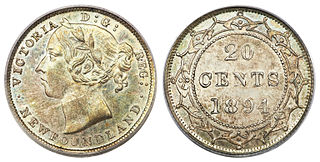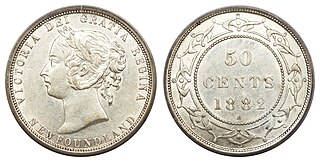
The dime, in United States usage, is a ten-cent coin, one tenth of a United States dollar, labeled formally as "one dime". The denomination was first authorized by the Coinage Act of 1792. The dime is the smallest in diameter and is the thinnest of all U.S. coins currently minted for circulation, being .705 inch (17.91 mm) in diameter and .053 inch (1.35 mm) in thickness. The obverse of the current dime depicts the profile of President Franklin D. Roosevelt and the reverse boasts an olive branch, a torch, and an oak branch, from left to right respectively. As of 2011, the dime coin cost 5.65 cents to produce.

The fifty-cent piece is the common name of the Canadian coin worth 50 cents. The coin's reverse depicts the coat of arms of Canada. At the opening ceremonies for the Ottawa branch of the Royal Mint, held on January 2, 1908, Governor General Earl Grey struck the Dominion of Canada's first domestically produced coin. It was a silver fifty-cent piece bearing the effigy of King Edward VII.

In Canada, a penny is a coin worth one cent, or 1⁄100 of a dollar. According to the Royal Canadian Mint, the official national term of the coin is the "one-cent piece", but in practice the terms penny and cent predominate. Originally, "penny" referred to a two-cent coin. When the two-cent coin was discontinued, penny took over as the new one-cent coin's name. Penny was likely readily adopted because the previous coinage in Canada was the British monetary system, where Canada used British pounds, shillings, and pence as coinage alongside U.S. decimal coins and Spanish milled dollars.
The coins of Newfoundland are of historical importance as Newfoundland was a British colony until 1907, and a Dominion until 1949, when Newfoundland and Labrador became the tenth province of Canada.

The Canadian Silver Maple Leaf is a silver bullion coin that is issued annually by the Government of Canada. It is produced by the Royal Canadian Mint.
Canadian coinage is the coinage of Canada, produced by the Royal Canadian Mint and denominated in Canadian dollars ($) and the subunit of dollars, cents (¢). An effigy of the reigning monarch always appears on the obverse of all coins. There are standard images which appear on the reverse, but there are also commemorative and numismatic issues with different images on the reverse.
The Charlton Press, is a book publishing company, which produces pricing guides as well as other books on related topics, including; collectables,, and porcelain figures. The company's first title was Catalogue of Canadian Coins, Tokens & Fractional Currency, published in 1952 and contained all coins used as circulating tender in Canada from 1858 until present.
One of the most profitable aspects of the Royal Canadian Mint (RCM) is its numismatic product line. The first numismatic coin from the RCM was arguably the 1935 dollar commemorating the Silver Jubilee of His Majesty King George V. Though intended for circulation, it was the first Canadian coin commemorating an event. The decision to issue this coin was made in October 1934 by then-Prime Minister R.B. Bennett. There were economic and patriotic motivations for the release of a silver dollar, including a hope to boost the silver mining industry. In future years, the silver dollar would have a more emotional meaning for many Canadians because it was also the first coin to have the Voyageur motif on its reverse.
Since the 1976 Summer Olympics in Montreal, the Royal Canadian Mint has struck Summer and Winter Olympic coins to mark Games held in Canada.

As Newfoundland did not join Canada until 1949, it had its own currency for many decades. It adopted its own decimal currency in 1863. Compared to other pre-Confederation British colonies, it had a wide selection of decimal coinage. The most important coin in Newfoundland was the Spanish American dollar, therefore, the Newfoundland government set its dollar equal in value to this coin. The new decimal cent was equal to the British halfpenny and $4.80 was equal to one pound sterling.

Work on the coinage tools for the Newfoundland five-cent coin began after the one-cent coin, so the coin has no legend. The first pattern is derived from the New Brunswick obverse with Newfoundland substituted for New Brunswick.

The first known pattern for the Newfoundland 20-cent piece is a bronze strike with an obverse derived from a New Brunswick coin. The reverse is from the die for the 1864 New Brunswick 20-cents. The twenty-cent denomination was very popular in Newfoundland and was minted on a consistent basis throughout the reign of Queen Victoria. Over the years the piece became unpopular with Canadians as it was easily confused with the Canadian 25-cent piece, which was similar in size and shape. Pressured by Canada, the government replaced it with a twenty-five cent coin during World War I.

Although twenty-cent coins were required during the reign of King George V, arrangements were being made to replace the denomination. The Ottawa Mint was going to start producing Newfoundland’s coins and Canadians did not like the Newfoundland twenty-cent piece. Newfoundland coins circulated throughout Canada as well and the Newfoundland twenty-cent coin was often confused with Canadian twenty-five cent coins. The Canadian government convinced Newfoundland’s government to discontinue the twenty-cent coin. A twenty-five coin was introduced and struck on the same standard as the corresponding Canadian coin. The obverse of the coin was exactly the same as that of the Canadian twenty-five cent coin.

The Newfoundland fifty cent piece was the last denomination to be added to the Victorian coinage. Its first year of issue was 1870. The laureate portrait is stylistically unlike anything used for the rest of British North America. The denomination became very popular and assumed importance after the failure of the Commercial and Union Banks of Newfoundland during the financial crisis of 1894.
The Canadian silver dollar was first issued by the Royal Canadian Mint in 1935 to commemorate the Silver Jubilee of King George V. The coin's reverse design was sculpted by Emanuel Hahn and portrays a voyageur and a person of Indigenous descent paddling a birch-bark canoe. The faint lines in the background represent the Northern Lights. The voyageur design was used on the dollar until 1986. It was then replaced with the 1987 Canadian 1-dollar coin. 1967 marked the end of the silver dollar as a business strike, or a coin issued for circulation. After 1967, the dollar coin was made of nickel, except for non-circulating commemorative issues for the collector market, which continue to contain silver.
One of the most highly profitable aspects of the Royal Canadian Mint’s enterprise is in its Numismatic product line. The euphoria surrounding the year 2000 led to the birth of the Millennium 25-cent coin program. The numismatic line included proof quality coins sold individually or as a complete set. This level of excess would come to signify the coming decade. The number of numismatic releases would increase on an annual basis starting in 2003. Numismatic three cents, five cents, and ten cents would be introduced, along with numismatic three dollars and eight dollars. Luxury coins would not be immune to the dramatic increases that ensued. Coins with face values of 250, 300 and 350 dollars would be introduced by 2006.
The Royal Canadian Mint has made coins with various themes. Most recently, ice hockey has been used for many numismatic releases. The first known ice hockey coin was for the 1988 Winter Olympics. Issued on February 25, 1986, the coin featured a goalie on the coin. Edge lettering was also used for the coin, the first time that it was used on silver coins.
Starting in 1997, the Royal Canadian Mint started to sell hockey medallions to the public. To commemorate the induction of Mario Lemieux in the Hockey Hall of Fame, a set was issued honouring all three inductees. One set was issued in Sterling Silver while another was issued in Nickel. The success of the release led to future issues.

The Newfoundland 2-dollar coin was issued in intermittent years between 1865 and 1888. It was the only circulation gold coin issued by a British colony. Although few coins were issued, it was broadly used in Newfoundland and eastern Canada. The coin became scarce in 1894 because of hoarding following the collapse of Newfoundland's banks and monetary system.




















